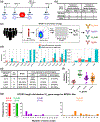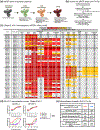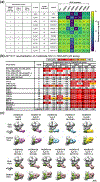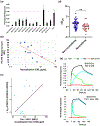Vaccine induction of heterologous HIV-1-neutralizing antibody B cell lineages in humans
- PMID: 38761800
- PMCID: PMC11993910
- DOI: 10.1016/j.cell.2024.04.033
Vaccine induction of heterologous HIV-1-neutralizing antibody B cell lineages in humans
Abstract
A critical roadblock to HIV vaccine development is the inability to induce B cell lineages of broadly neutralizing antibodies (bnAbs) in humans. In people living with HIV-1, bnAbs take years to develop. The HVTN 133 clinical trial studied a peptide/liposome immunogen targeting B cell lineages of HIV-1 envelope (Env) membrane-proximal external region (MPER) bnAbs (NCT03934541). Here, we report MPER peptide-liposome induction of polyclonal HIV-1 B cell lineages of mature bnAbs and their precursors, the most potent of which neutralized 15% of global tier 2 HIV-1 strains and 35% of clade B strains with lineage initiation after the second immunization. Neutralization was enhanced by vaccine selection of improbable mutations that increased antibody binding to gp41 and lipids. This study demonstrates proof of concept for rapid vaccine induction of human B cell lineages with heterologous neutralizing activity and selection of antibody improbable mutations and outlines a path for successful HIV-1 vaccine development.
Copyright © 2024 The Authors. Published by Elsevier Inc. All rights reserved.
Conflict of interest statement
Declaration of interests B.F.H. and S.M.A. have US patents 9402917, 9402893, 9717789, and 10588960 and US patent application 63/540482. B.F.H., S.M.A., and B.K. have US patent 10076567. B.F.H. and K.O.S. have patent applications PCT/US2023/077677 and PCT/US2023/077686. C.B.F. has patents on PEGylated liposomes.
Figures






References
-
- Rerks-Ngarm S, Pitisuttithum P, Nitayaphan S, Kaewkungwal J, Chiu J, Paris R, Premsri N, Namwat C, de Souza M, Adams E et al. 2009. Vaccination with alvac and aidsvax to prevent hiv-1 infection in thailand. N Engl J Med. 361(23):2209–2220. - PubMed
MeSH terms
Substances
Grants and funding
LinkOut - more resources
Full Text Sources

